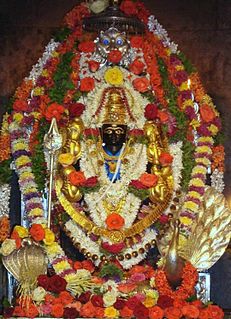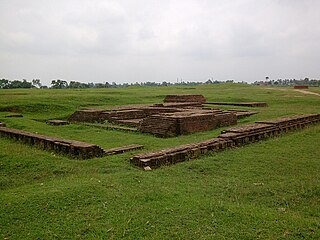Related Research Articles

Kshatriya is one of the four varna of Hindu society, associated with warrior aristocracy. The Sanskrit term kṣatriyaḥ is used in the context of Vedic society wherein members were organised into four classes: brahmin, kshatriya, vaishya and shudra.

The Brahmanas are Vedic śruti works attached to the Samhitas of the Rig, Sama, Yajur, and Atharva Vedas. They are a secondary layer or classification of Sanskrit texts embedded within each Veda, often explain and instruct Brahmins on the performance of Vedic rituals. In addition to explaining the symbolism and meaning of the Samhitas, Brahmana literature also expounds scientific knowledge of the Vedic Period, including observational astronomy and, particularly in relation to altar construction, geometry. Divergent in nature, some Brahmanas also contain mystical and philosophical material that constitutes Aranyakas and Upanishads.

Kayastha denotes a cluster of disparate Indian communities broadly categorised by the regions of the Indian subcontinent in which they were traditionally located—the Chitraguptavanshi Kayasthas of North India, the Chandraseniya Kayastha Prabhus of Maharashtra and the Bengali Kayasthas of Bengal. All three were traditionally considered "writing castes", who had historically served the ruling powers as administrators, ministers and record-keepers.

Shashanka was the first independent king of a unified polity in the Bengal region, called the Gauda Kingdom and is a major figure in Bengali history. He reigned in the 7th century, some historians place his rule between circa 600 CE and 636/7 CE, whereas other sources place his reign between 590 and 625 CE.

The Bengali Brahmins are Hindu Brahmins who traditionally reside in the Bengal region of the Indian subcontinent, currently comprising the Indian state of West Bengal and the country of Bangladesh. When the British left India in 1947, carving out separate nations, many Brahmins, whose original homes were in the newly created Islamic Republic of Pakistan, migrated en masse to be within the borders of the newly defined Republic of India, and continued to migrate for several decades thereafter to escape Islamist persecution.

Rakhaldas Bandyopadhyay, also known as R D Banerji, was an Indian archaeologist and museum expert. He was the Manindra Chandra Nandy Professor of Ancient Indian History and Culture at the Banaras Hindu University from 1928–30. He is best known as the discoverer of the antiquity of Mohenjo-daro, the principal site of the Indus Valley Civilisation through excavations.
Kulin Brahmins are a relatively small subset of the Bengali Brahmins belonging to Hindu religion. They trace themselves to the four families of Kannauj in North India who migrated to Bengal.

Sthānika Brāhmins belong to Hindu Tuluva Smartha Brahmin group.

Pundravardhana or Pundra Kingdom, was an ancient kingdom during the Iron Age period in South Asia with a territory that included parts of present-day Rajshahi, Rangpur and Dhaka Divisions of Bangladesh as well as the West Dinajpur district of West Bengal, India. The capital of the kingdom, then known as Pundranagara, was located at Mahasthangarh in Bogra District in northern Bangladesh.

Kajangala, refers to a territory located near Rajmahal in ancient times, in eastern part of India.

Bangarh is an ancient city situated in Gangarampur, West Bengal, India. Bangarh was the ancient city which was the administrative centre of Kotivarsha Vishaya, itself part of the wider administrative unit of Pundravardhana Bhukti, which had Mahasthangarh as its capital in the period of Chandras, Varmans and Senas. After the Senas were defeated by the Muslims under Bakhtiar Khilji, Devkot was established as their capital where Bakhtiar died.
Jyotirishwar Thakur or Kaviśekharācārya Jyotirīśvara Ṭhākura (1290–1350) was a Maithil poet and an early Maithili and Sanskrit writer, known for the Varṇa Ratnākara, his encyclopedic work in Maithili.
Khare is a Hindu family surname found in India among communities of Kayastha or Kayasth and Kaushik and takes its meaning from the word 'pure'. Kāyastha are said to have a higher upper class status and in the Vedas and Puranas to have a dual-caste status, i.e. Brahmin and Kshatriya. They are mainly spread across Madhya Pradesh, Rajasthan, Uttar Pradesh and few in the Konkan region of Maharashtra, North India and are a sub-sect of Brahmins whose ancient profession was writing. The Khare family is known for their success in business, medicine as well as discovery and research in the field of science(biochemistry). They are the only sect who are referred to as direct “blood” descendants of a Vedic god (Chitragupta) in the religious texts.

Gauda, was a territory located in Bengal in ancient and medieval times, as part of the Gauda Kingdom. 11th Century Persian scholar Al-Biruni mentioned it as Purva-Desa or Eastern Country.

Karnasuvarna or Karnasubarna was an ancient city, located in the present day Berhampore CD block in the Berhampore subdivision of Murshidabad district, West Bengal, India.

Kulin Kayasthas are a sub-caste of the Kayastha caste in Bengal, India. They are also known as the Kulina Kayasthas.
Baidya or Vaidya is a Hindu community of Bengal. A caste/jāti of Ayurvedic physicians, Baidyas have long occupied a place of pre-eminence in society alongside Brahmins and Kayasthas. In the colonial era, the Bhadraloks were drawn from these three castes, who continue to maintain a collective hegemony in West Bengal.
Maitra, alternatively spelled Moitra or Maitreya, is a Bengali Hindu family name found among the Bengali Brahmins of the Varendra clan.

Gauḍa Kingdom, was a classic kingdom during the Classical period on the Indian subcontinent, which originated in the region of Bengal in 4th century CE or possibly earlier.

Bengali Kayastha is a Bengali Hindu who is a member of the Kayastha community. The historical caste occupation of Kayasthas throughout India has been that of scribes and administrators; the Kayasthas in Bengal along with Brahmins and Baidyas, are regarded among the three traditional higher castes that comprise the "upper layer of Hindu society." In the colonial era, the Bhadraloks of Bengal were drawn from these three castes, who continue to maintain a collective hegemony in West Bengal.
References
- 1 2 3 4 5 6 Majumdar, Dr. R.C., History of Ancient Bengal, Tulshi Prakashani, Kolkata, pages 442, 413, 409-415, first published 1971, first Tulshi edition, 2005. ISBN 81-89118-01-3
- ↑ "Dutta Chaudhuri Ancestry". 14 February 2021.
- ↑ Bandopadhayay, Rakhaldas, Banglar Itihas (History of Bengal), (in Bengali), Nababharat Publishers, Kolkata, page 103, 1979 edition.